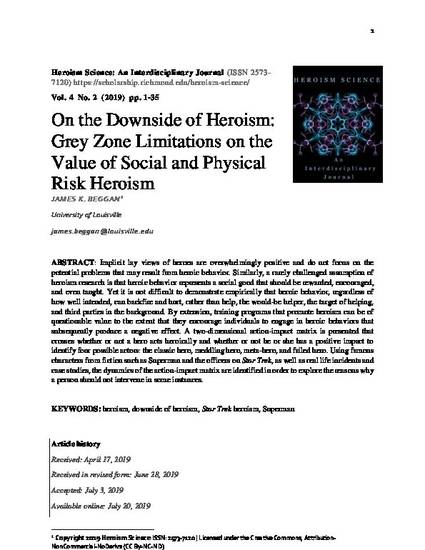
Article
On the Downside of Heroism: Grey Zone Limitations on the Value of Social and Physical Risk Heroism
Heroism Science
(2019)
Abstract
Implicit lay views of heroes are overwhelmingly positive and do not focus on the potential problems that may result from heroic behavior. Similarly, a rarely challenged assumption of heroism research is that heroic behavior represents a social good that should be rewarded, encouraged, and even taught. Yet it is not difficult to demonstrate empirically that heroic behavior, regardless of how well intended, can backfire and hurt, rather than help, the would-be helper, the target of helping, and third parties in the background. By extension, training programs that promote heroism can be of questionable value to the extent that they encourage individuals to engage in heroic behaviors that subsequently produce a negative effect. A two-dimensional action-impact matrix is presented that crosses whether or not a hero acts heroically and whether or not he or she has a positive impact to identify four possible actors: the classic hero, meddling hero, meta-hero, and failed hero. Using famous characters from fiction such as Superman and the officers on Star Trek, as well as real life incidents and case studies, the dynamics of the action-impact matrix are identified in order to explore the reasons why a person should not intervene in some instances.
Keywords
- heroism,
- downside of heroism,
- Star Trek heroism,
- Superman
Disciplines
Publication Date
2019
Citation Information
James K Beggan. "On the Downside of Heroism: Grey Zone Limitations on the Value of Social and Physical Risk Heroism" Heroism Science Vol. 4 Iss. 2 (2019) p. 1 - 35 Available at: http://works.bepress.com/scott_allison/99/
